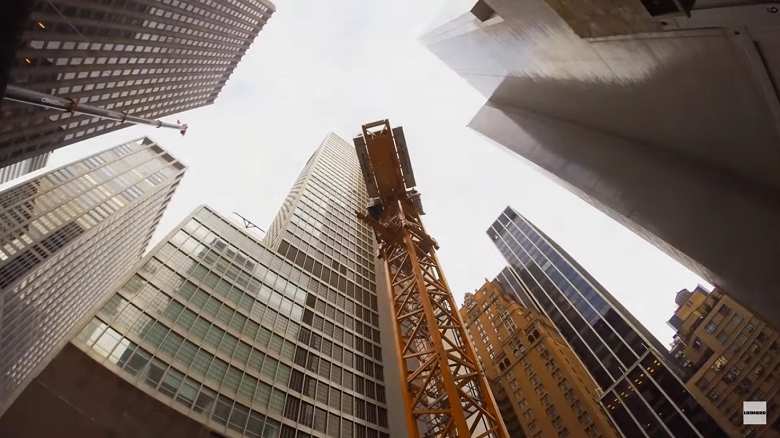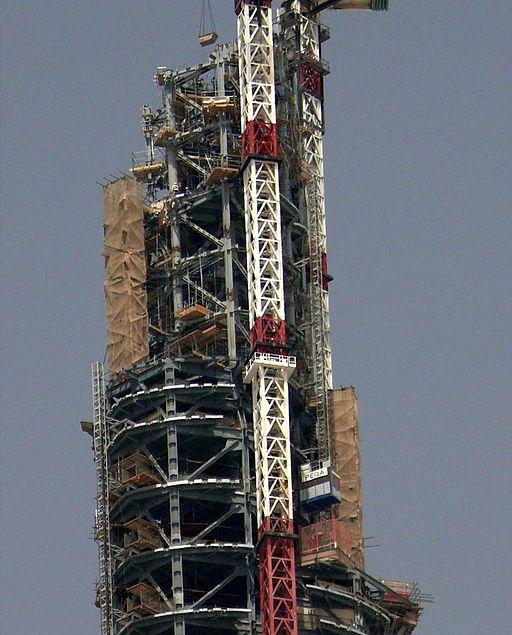Life in the ocean of air. What happens at 326 meters above Petersburg
For the first time the high-altitude line of St. Petersburg moved as far as 326 meters of 2011 when a new antenna was installed with the help of helicopters on the TV tower. This mark remained unapproachable until May 10 in 2017. At 9.50 in the morning, the builders of Lakhta Center poured the walls of the core of the 78 floor of the tower, which is a level of 327.6 meters. At the same time they exchanged the last ten floors. A little more than 20 months passed from the start of floor construction.

Find out what's up there? Our guides today are the people who drive the highest cranes in the city.
')
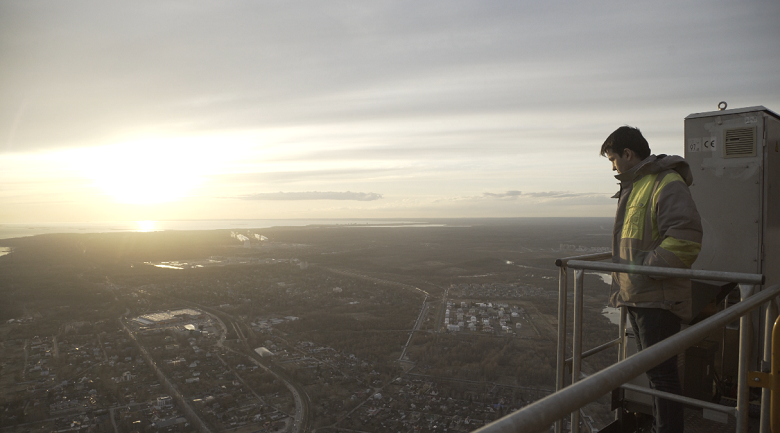
If you walk 326 meters along the road, it will take you about 4 minutes. The environment during this time is unlikely to change much. But if you go up the same distance, then there things are different.
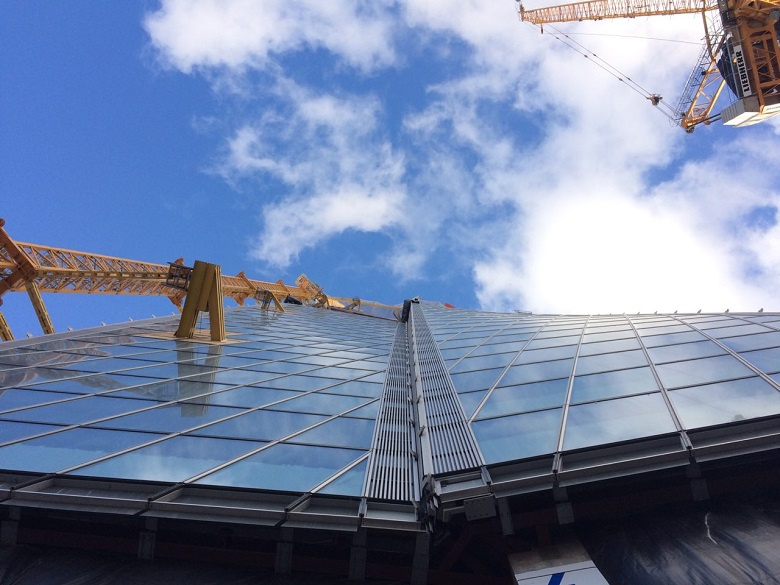
There is another air, wind and temperature. There are the paths of "bird migrants" and glide paths of aircraft. There, the lower cloudy tier rushes toward the fog rising from the ground. Mosquitoes do not fly there ... And skyscraper builders are working on this mark.
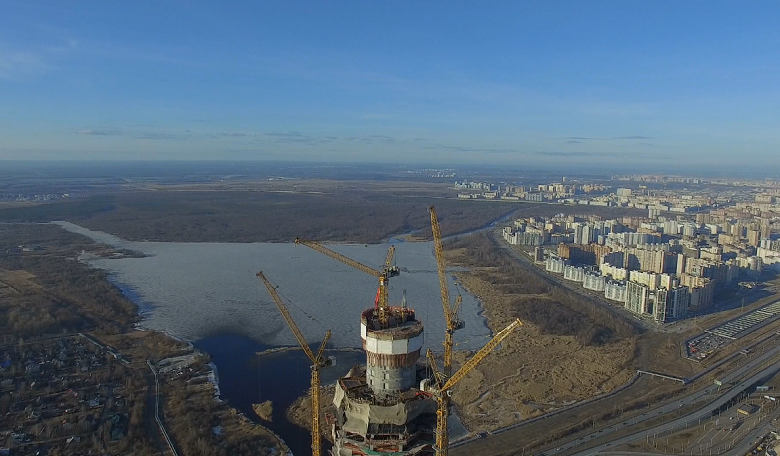
Above all - crane operators "K-1", "K-2", "K-3" and of course, "K-4" - a lifting machine, mounted in the core of the tower Lakhta Center. Rise to them. But first - we learn that they control the machines.
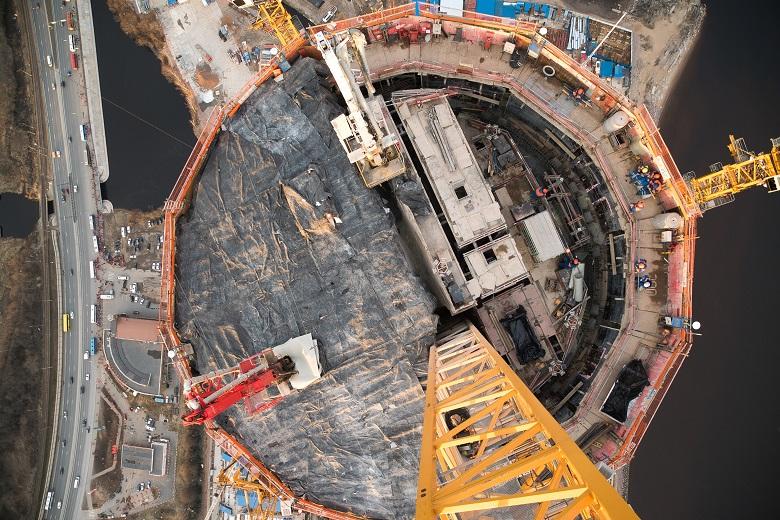
There are 16 lifting machines at the Lakhta Center construction site. At all - one name, "K", plus a serial number.
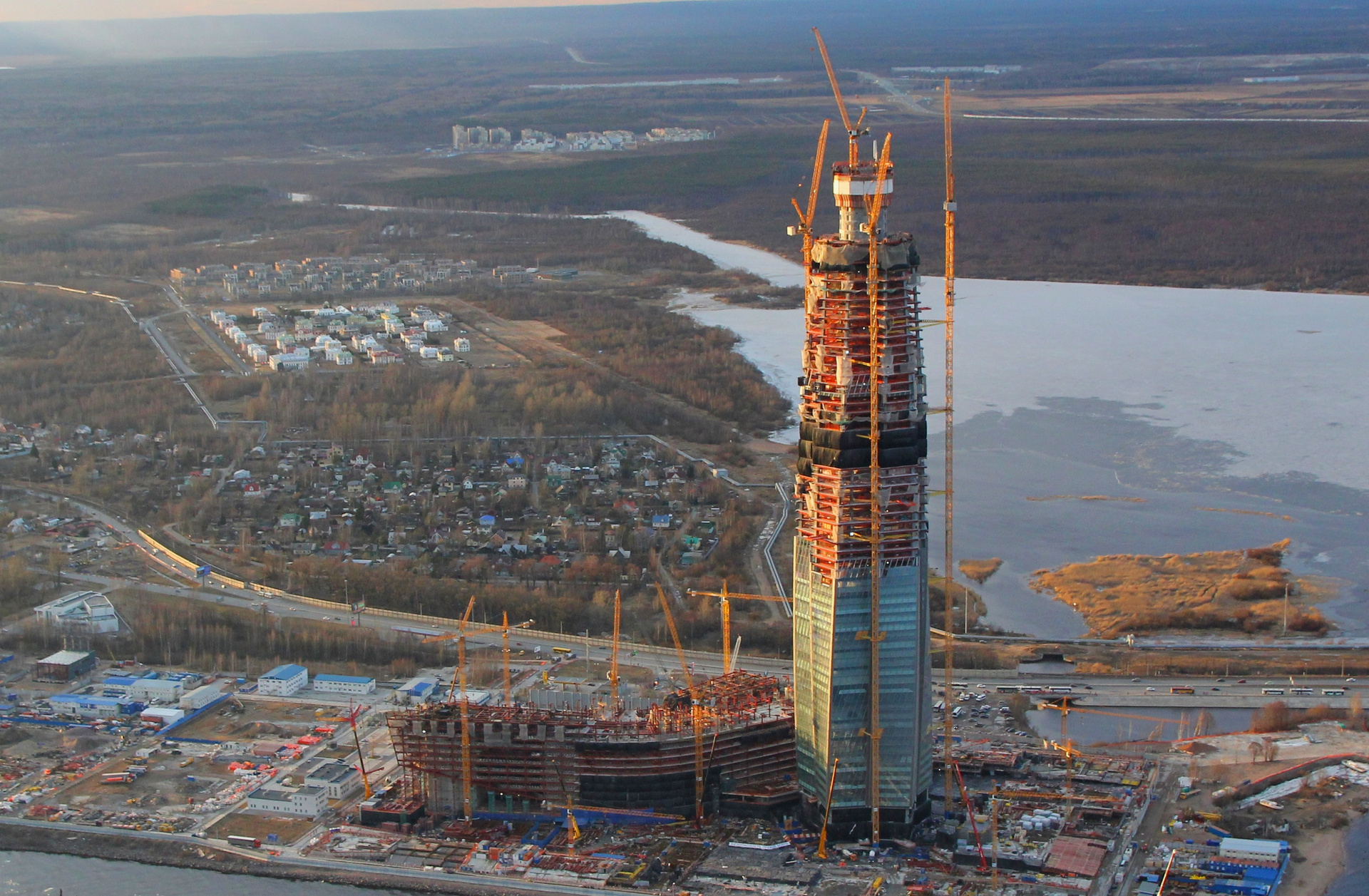
Construction site, April 2017
Cranes differ in type - there are classic cranes with a tip and with a swinging boom. The first is used to move goods horizontally, the second - for vertical transportation. It is possible to distinguish machines in the following way: cranes with a swinging arm can understand it almost vertically upwards, and the counterweight is located compactly on the platform next to the tower. In the "classic" arrow has a "tail" - a console with a counterweight.
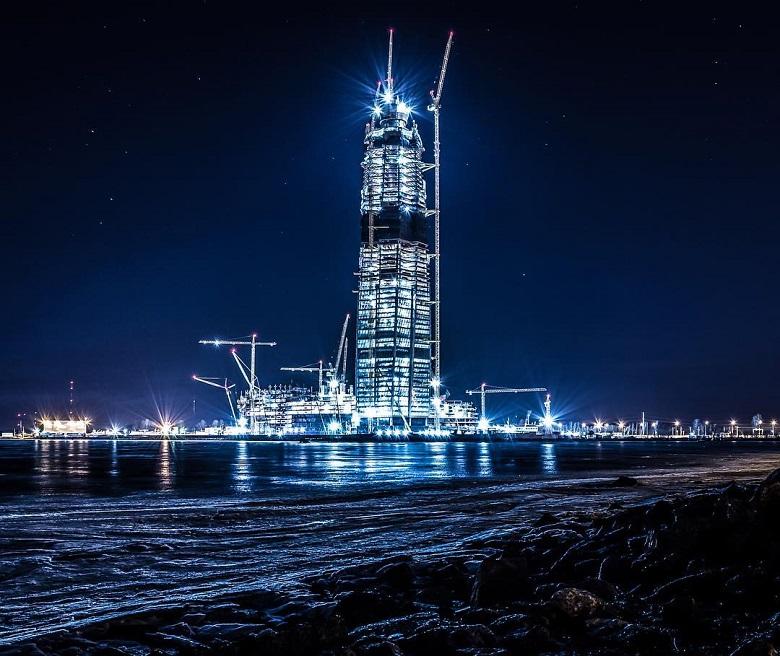
Photo - Ilya @yosivim Nekrasov
Above the multifunctional building work cranes, both traditional and with a swinging arm - three of each kind. At the height of the growth of the highest machines of this working group will reach 95 meters. It inspires, given that these are separate cranes that do not have a fastener to the building.
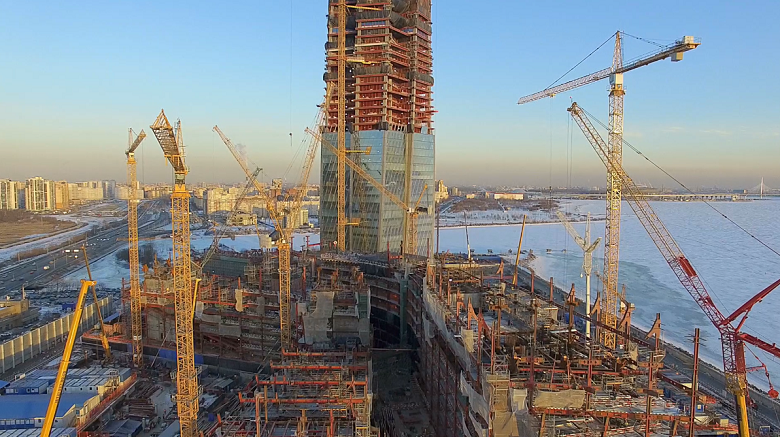
MFZ cranes
Above the construction of the flagship of the complex, the 462-meter tower, four supermachines are working. The disposition is as follows. Around the skyscraper are located "K-1", "K-2" and "K-3", model 710 HC-L 32/64 Litronic.
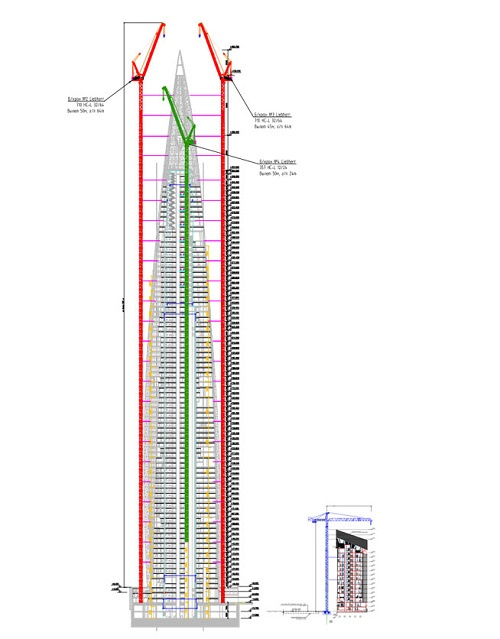
Layout of cranes for work with the building of a skyscraper. For comparison - next to the scale is a piece of the MFZ building and a crane for it.
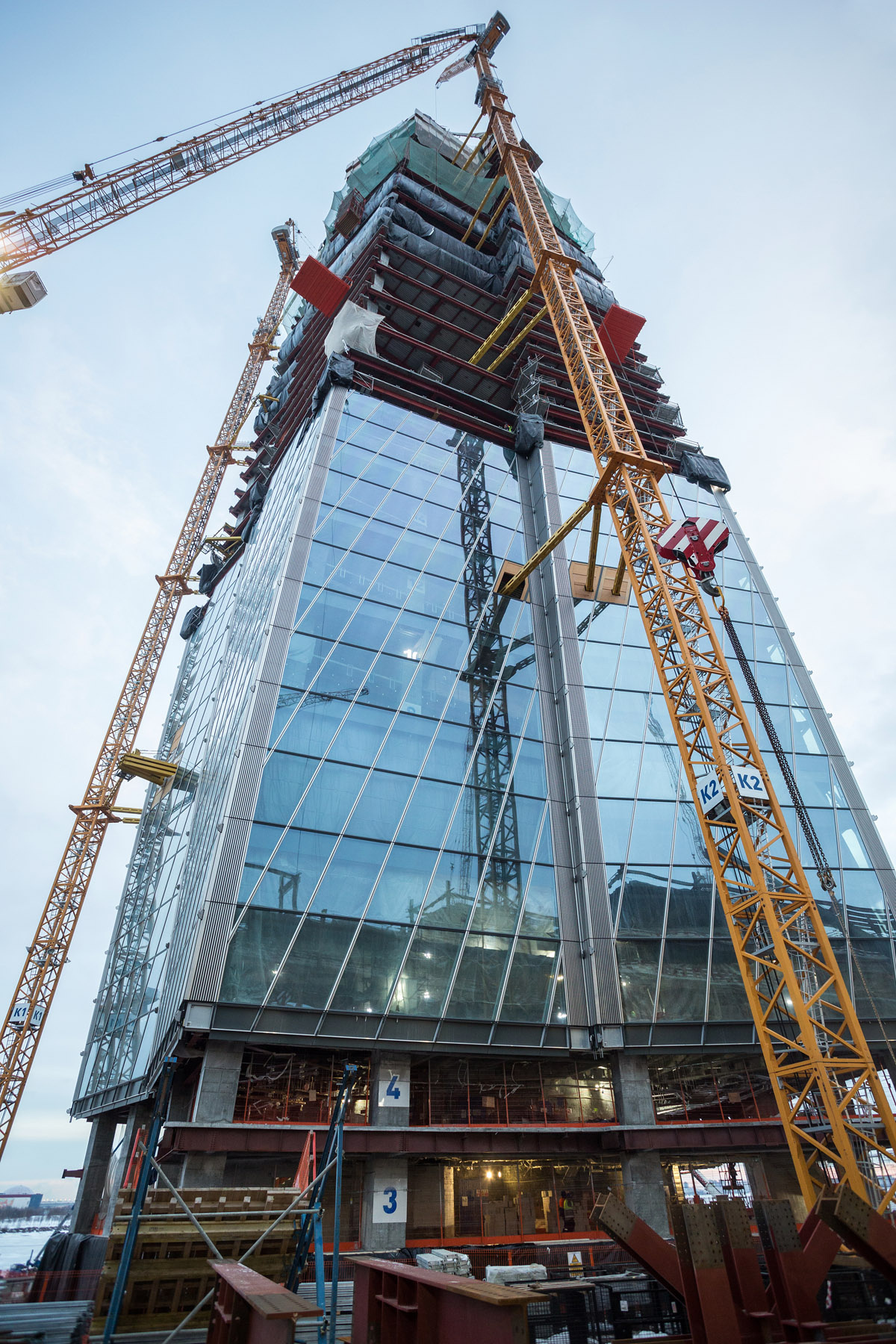
These are the highest cranes in the city. And in general - the biggest cranes with swinging arm, produced by "Liebherr". The departure of their arrows is 45, 50 and 60 meters. The maximum carrying capacity is 64 tons, the speed of movement of the load is 176 meters per minute. Faster than a regular elevator.
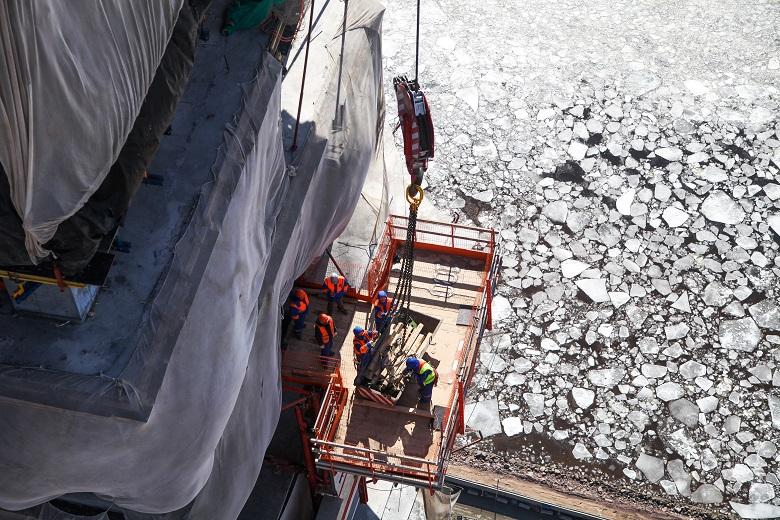
Cranes grow with the building — about a quarter of a time additional sections are added to the mast. At the peak of the growth of cars will step over the 400-meter mark. One of the "libkers" will grow to 440 meters already in the summer - it is with its help that the tower spire will be installed.
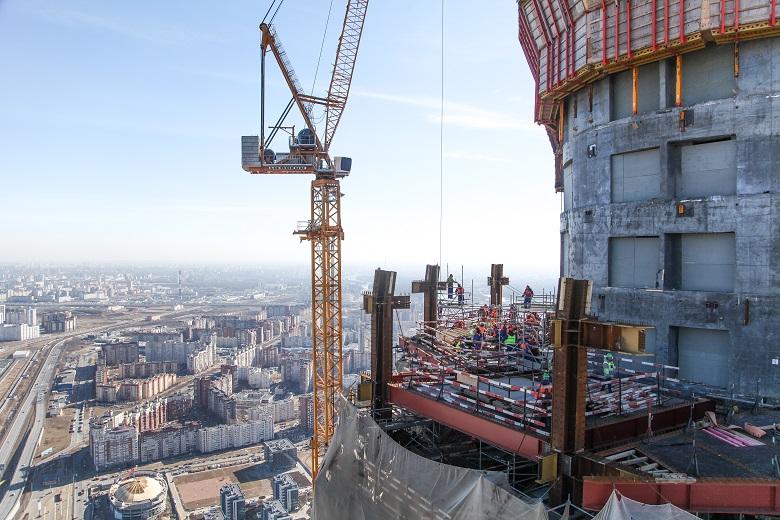
"K-2" took a height of 320 meters
Of course, these cranes have attachments to the building.
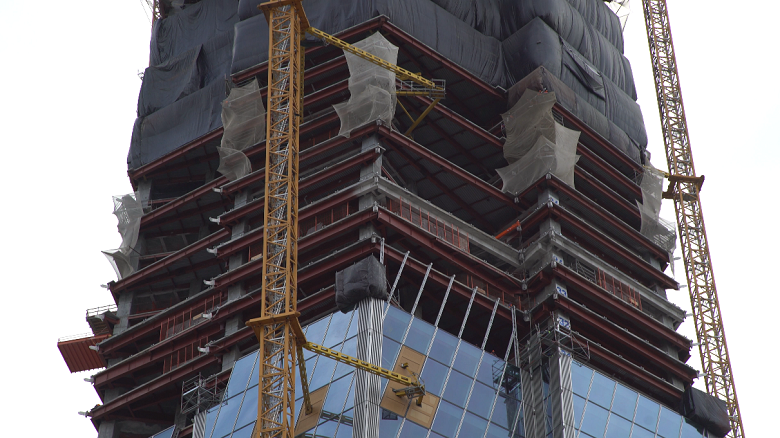
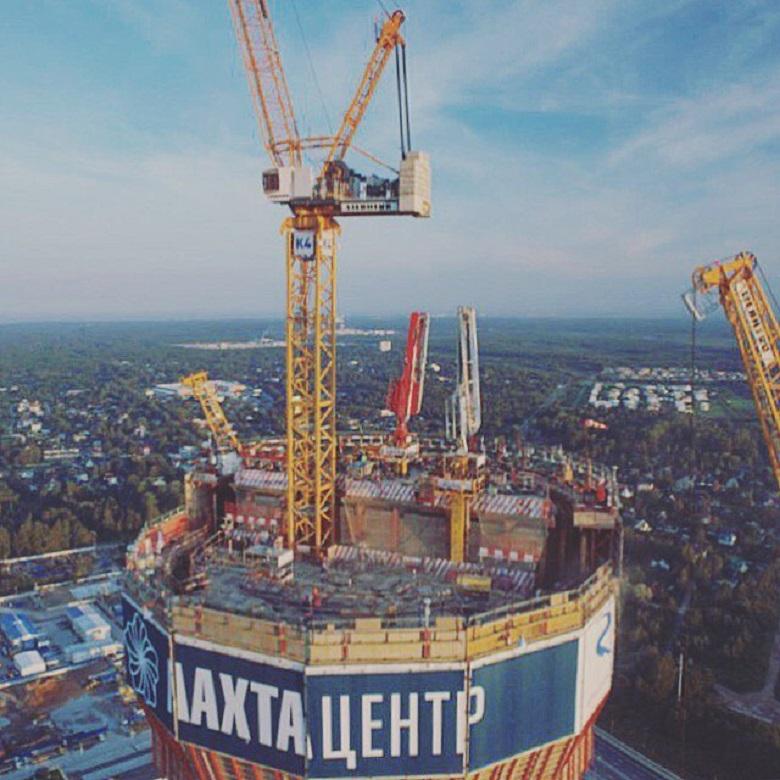
This machine closes the skyscraper quartet load. Although the K 4 is also the Liebherr, model 357 HC-L 12/24, it is, in a way, a legacy of Soviet engineers. In the 50s of the last century, when Stalin's skyscrapers were erected, UBK - universal tower cranes were first tested. Development of engineers P. P. Velikhov, L. N. Shchipakina, I. B. Gitman and A. D. Sokolov. Everyone was awarded the Stalin Prize for this work.
The essence of innovation is as follows. The UBC, and now its “heirs,” do not have the traditional ground support with a mast build-up during the construction process. It relies on the construction of the building itself. The building is growing - the crane moves to a new level. Therefore, it is also called self-climbing or creeping.
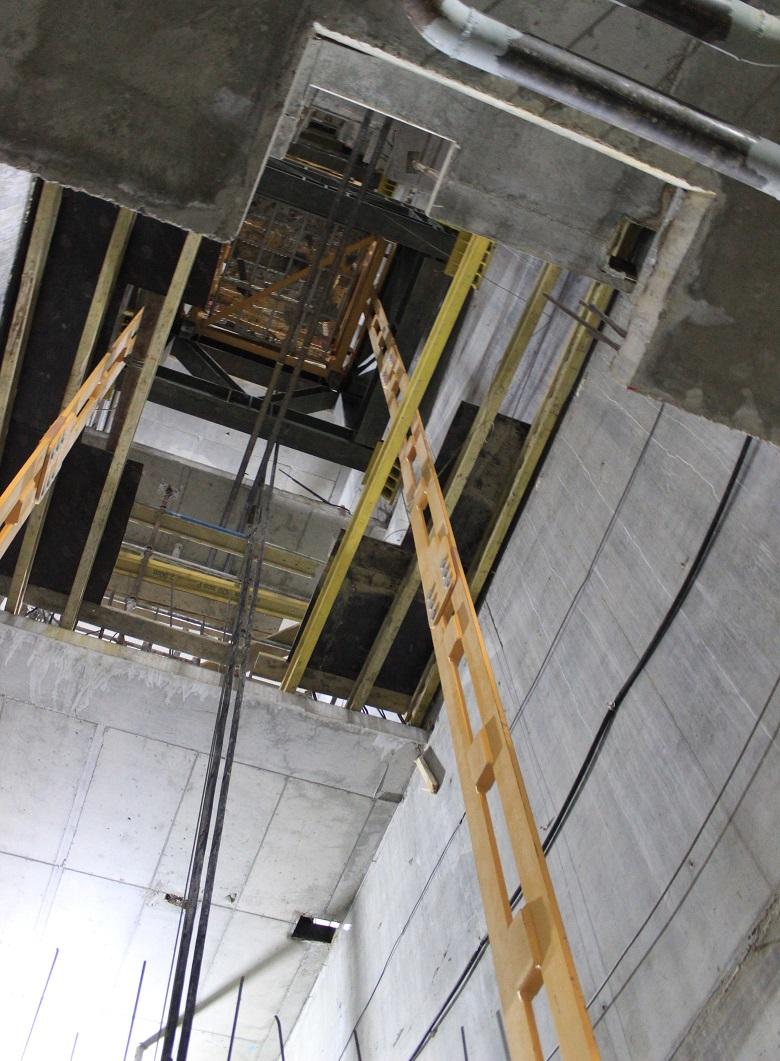
"K 4" is mounted in the elevator lobby of the core of Lakhta Center. To change positions, the crane is lifted hydraulically and a new section is built in.
It turns out that the height of the work of such a crane is limited only by the growth of the building. You understand who most appreciated this innovation. Take a photo strongly of any skyscraper during construction, and in the center of the core you will see a self-lifting worker. Sometimes - not even one. Unfortunately, he still cannot completely replace the traditional tap. But this is a quick and easy forward, always at the peak of the process.

K-4 is now at the zenith of construction. His boom reaches up to 417 meters, the cabin has a height of 380. Views from there are the same ones that will be on the observation platform of a skyscraper, only earlier and without a queue. Look in?
The path to the cabin is one - the stairs. There are no special elevators in the crane for this purpose.
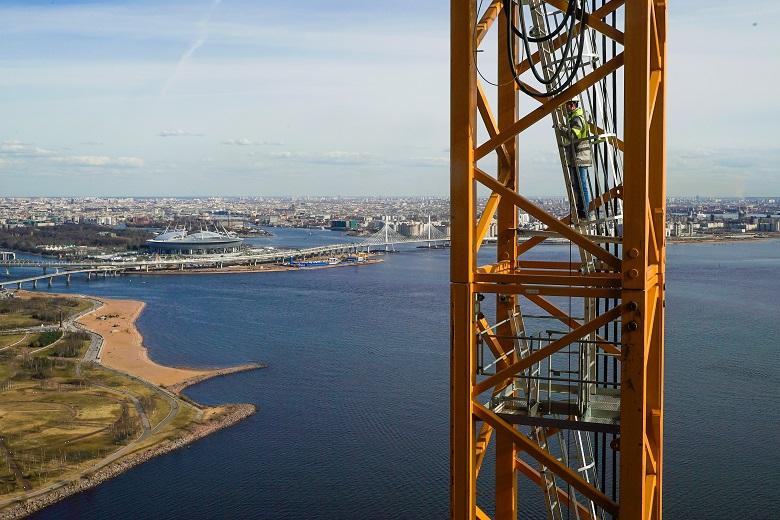
Can fellow crane operators "toss" each other at work and back? No, because of the first and sufficient - is unacceptable for safety. Violation is possible only in extreme cases. Last winter, when the support of the WHSD under construction caught fire, crane operator Tamara Pastukhova lowered 3 workers from a 100-meter height in an improvised “cradle”. Such situations transportation of people by crane and limited.
However, it is still possible to cut the way up a bit. In Lakhta Center, crane operators drive up to the 55th floor in an elevator located in the tower itself. From there - on the transition ladder get over to the crane mast. But further - without options, on foot.
Transition bridge:

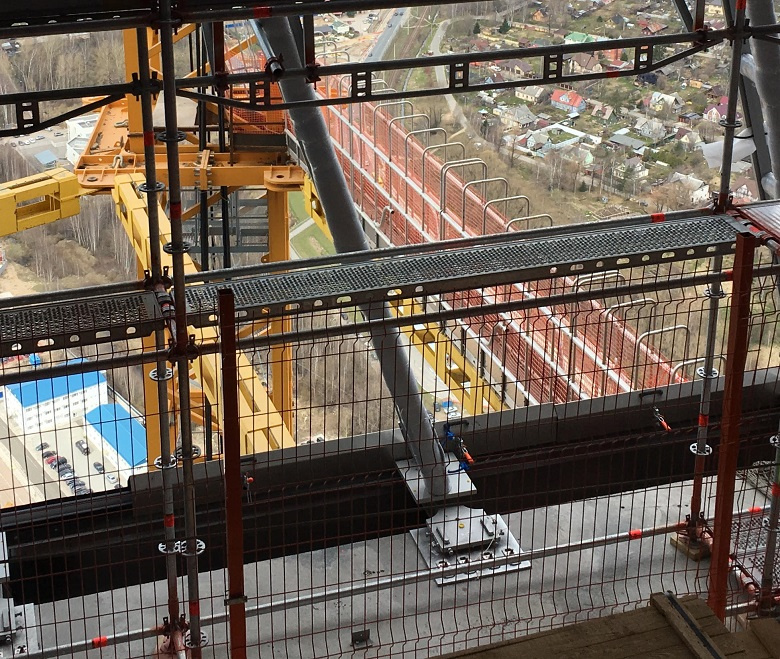
If it were not for this maneuver, then to climb into the cabin "K-1", "K-2" or "K-3", it would be necessary to overcome more than 700 steps. Those who work at K-4 are more fortunate - the height of the cabin is “only” 50 meters, but you cannot block the road either.
In any case - the crane operator once again does not run down. Even they have lunch at home. Tea can be drunk on the spot. But a hot lunch is delivered from the ground.
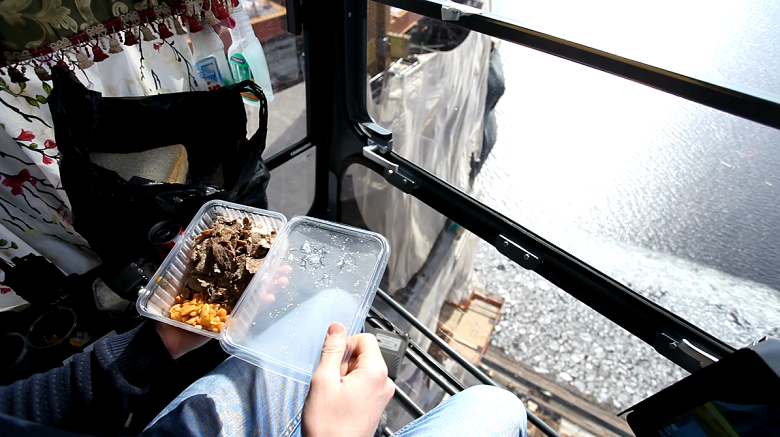
Lunch with a view is better than in a panoramic restaurant.
After the march to the workplace - sit-down 8-hour shift in a small cabin. Everything you need here is at hand. Two levers are responsible for turning the tower and lifting the load.
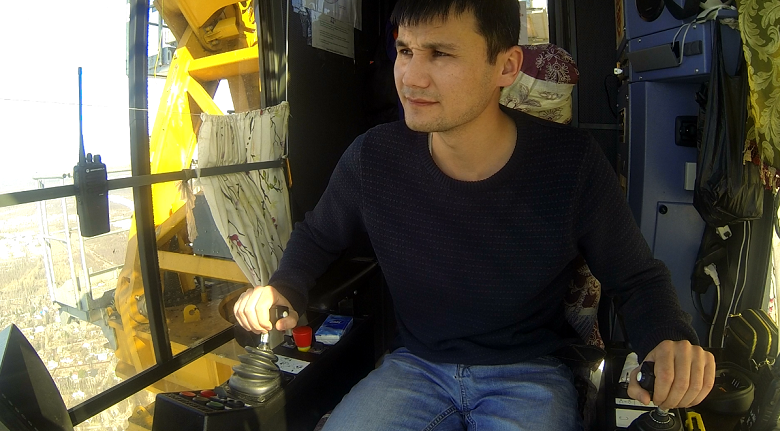
The on-board computer displays the current parameters - boom reach, load capacity, rope length, turning radius and wind speed.
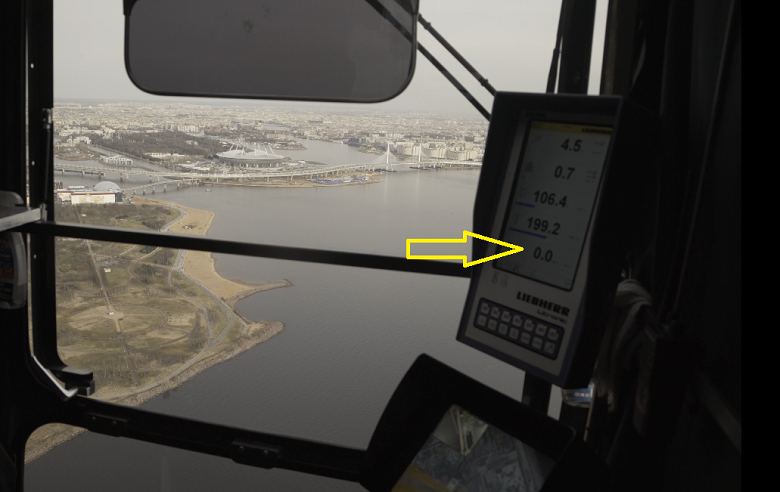
On the monitor - a unique minute - calm. Perhaps this will happen again for a brief moment once or twice a year.
“The most difficult thing in our work is the weather,” says Sordar, manager of K 2. “The weather like this is not hard.” I hope one or two days this normal weather will stay. Usually - constant wind.
Wind has to take into account all who work in the air. But if it is sometimes for aircraft only to help, then for wind cranes any wind is a hindrance. During a storm, work has to be stopped altogether. In this case, the flywheel boom cranes rise up for greater stability of the machines.
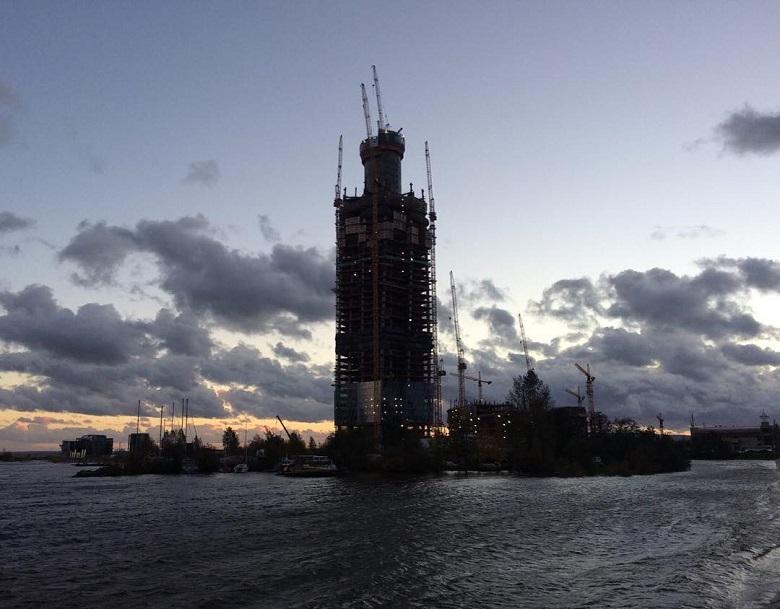
Storm. Fly arrows - in the wind, turning mechanism - on the "neutral" - for minimal resistance to impulses
Weather - the only thing that brings construction. "Distinguished" the last two years. In 2015, there were 159 storm warnings, in 2016 - already 258. 2017 seems to be going to continue the progression. But the wind is not everything. Most of the time, crane operators carry their loads “by instrument”.
- When the fog starts, we will have a hard work. We will only be on the radio working teams listen. But nothing will be visible below. In this weather, like today, work normally. But what is below is also not clearly visible. Through the camera look. And slingers listen.
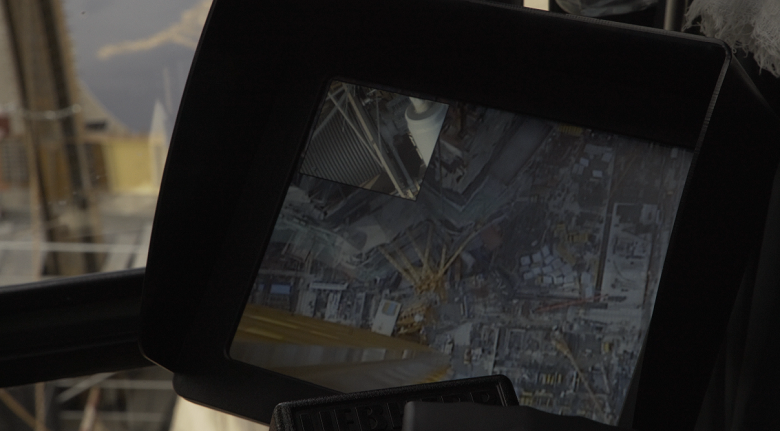
Camera "bottom view"
Poor visibility - not just because of the height, rain or fog. The skyscraper and its cranes have grown to the clouds.
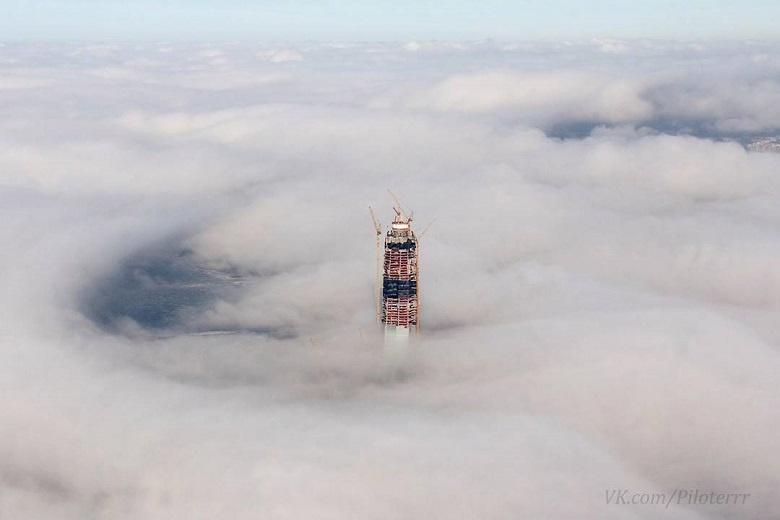
Photos of Nikolai Ivanov
Clouds are not always about kilometers above the ground. The base of their lower tier can begin even from a hundred meters.
There are two low cloud types at once - clouds are layered and simply layered. The former are also called “bad weather clouds” and everything is clear with them. But the second type is characterized by increased deceit towards builders. On his conscience - a good dozen of false calls of fire and rescue services at the construction site.
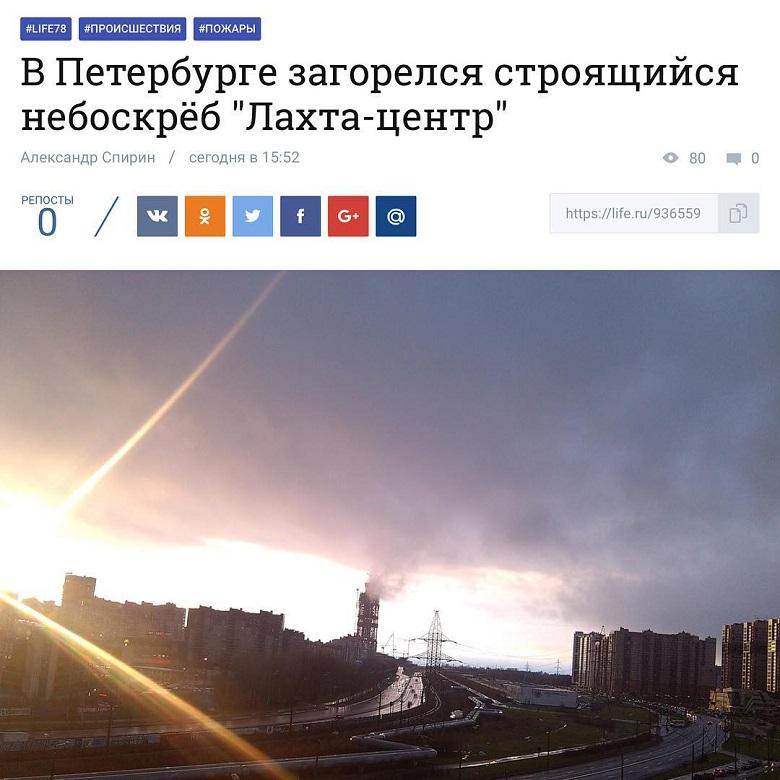
And such "state of emergency" for the year was not one
It's all about shape and color. Such low stratus clouds have the form of "ragged" and "torn", "resemble the fog." But it is only when they abstractly float across the sky, attracting the attention of only weather forecasters. If such a cloud is unaccompanied during the flight, it is not far from the tower, then many immediately realize: “fire!”
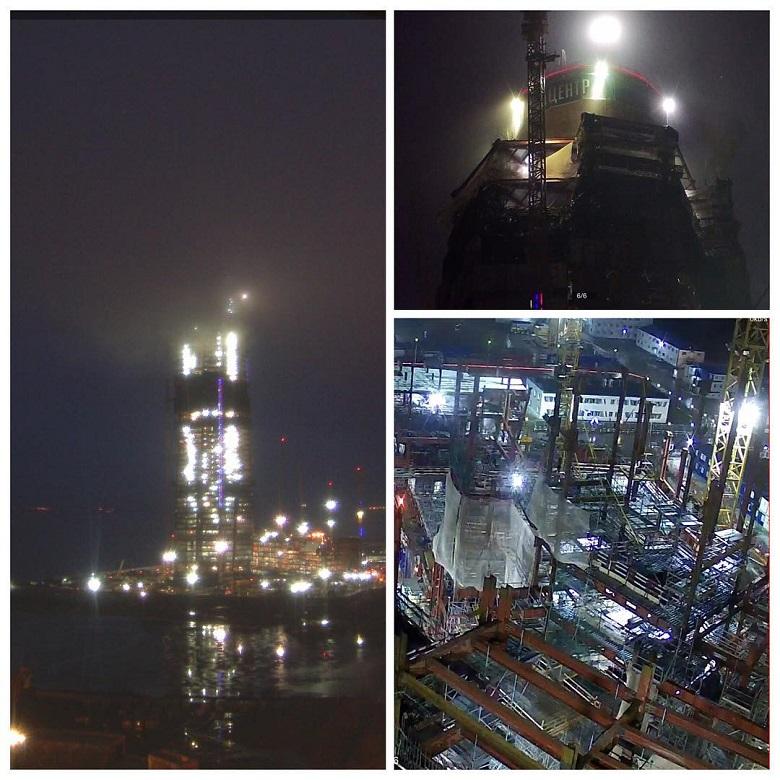
The press service tirelessly thanks the citizens for their vigilance and non-indifference, but asks first to clarify the causes of "smoke" in the Lakhta Center. Even in the event of a real state of emergency, there is a 24-hour fire brigade at a construction site and it will take all the necessary measures.
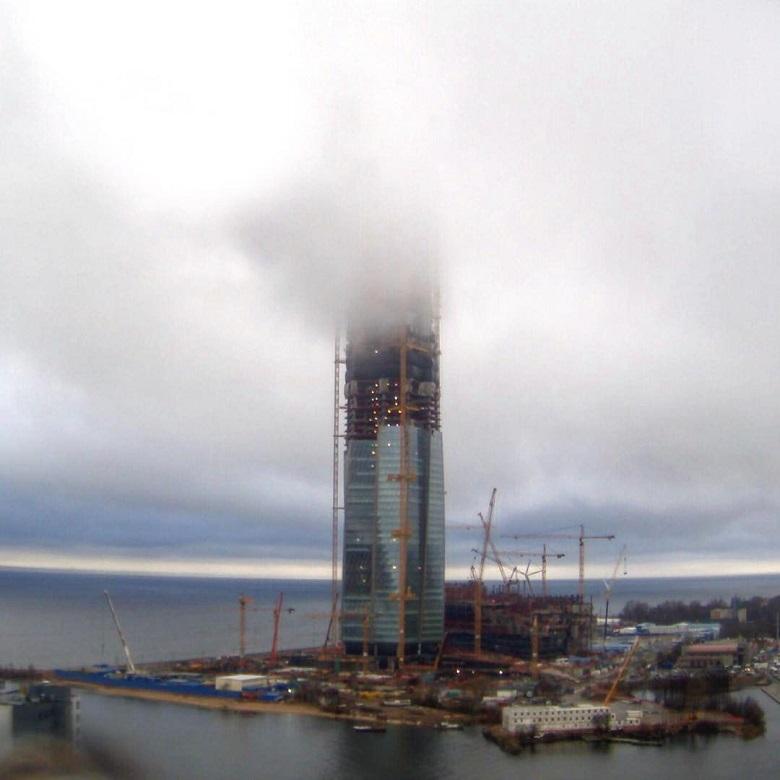
If we ignore the unusual properties of clouds to cause panic, we can recall that this weather phenomenon is simply beautiful. There is even a “Cloudy Floor” in the London Splinter to watch him.
But the clouds from the cranes of a skyscraper.
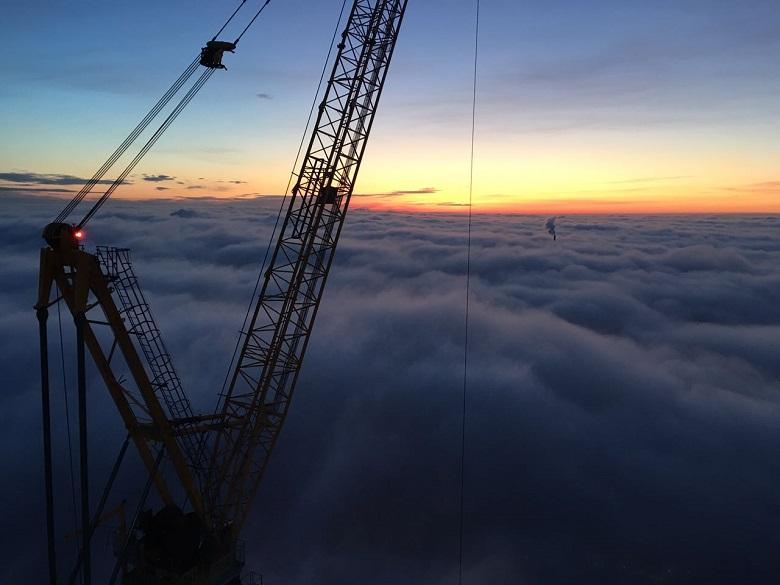
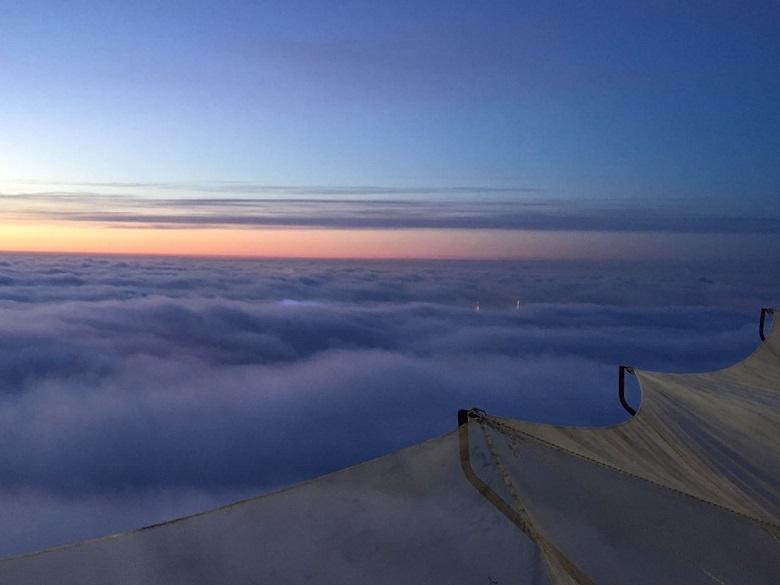
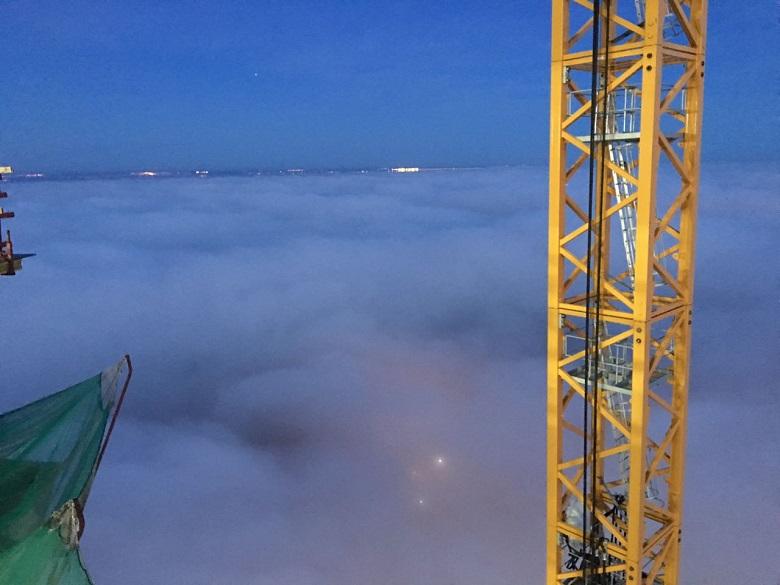
The photo with the clouds was made by the leading engineer of the building control department of Lakhta Center Alexey Sivoho
But the unforgettable - the first meeting with low clouds and rising mist.
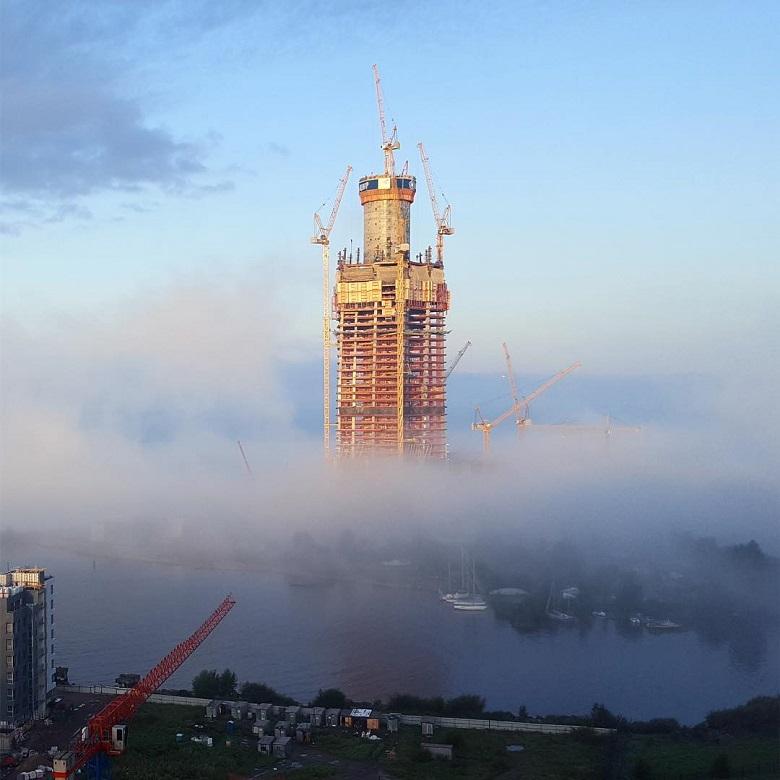
August 2016. Photographer - Aleksey Mayorov
The average number of sunny days in St. Petersburg is about 70. But the crane operators of the skyscraper have more of them - due to reaching the lower edge of the clouds. This is sometimes enough to see the sun.

The cabin has a visor with dimming. But it is clearly not enough - crane operators are saved by thick curtains. In case of heat there are vents. In the breaks, you can go out to warm up on a small platform and see the most beautiful sunrises or sunsets in St. Petersburg.
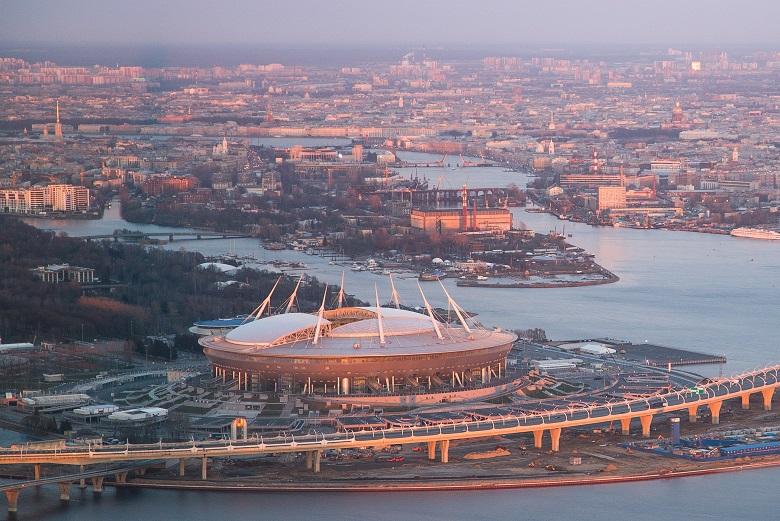
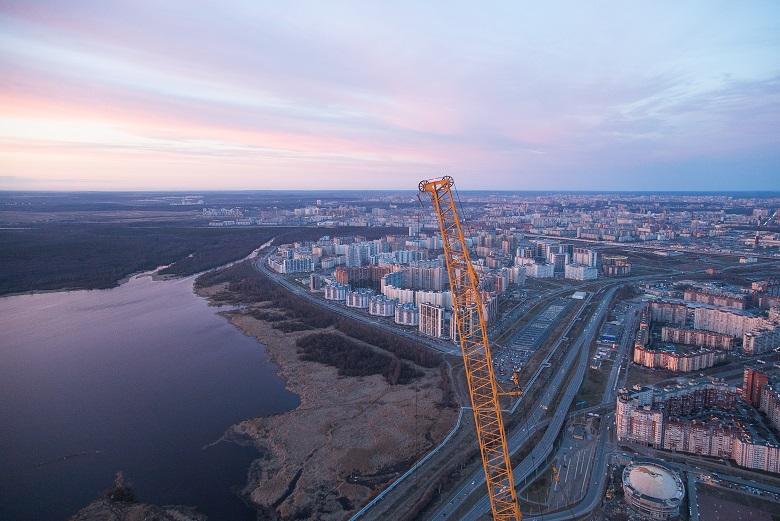
326 meters - atypical height for aircraft flight. Nevertheless, in the lower corridor you can often notice small helicopters - for short distances, climbing may be unnecessary.
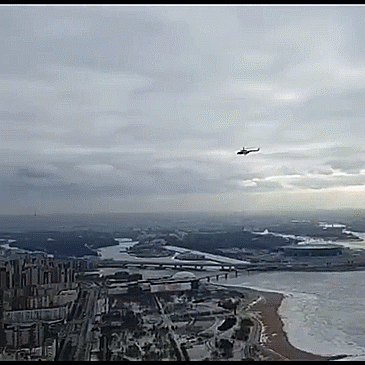
Small aircraft does not lag behind either - perhaps to show beautiful views of the city to its passengers. Soon such panoramas will be available from the Lakhta Center observation platform.

Sea facade of St. Petersburg - view from the crane
For large aircraft 326 meters - "shallow", below the height of the circle. This is just for takeoff or landing. "Rosaviatsia" by the way, the skyscraper approved - the glide paths are held in another part of the city. A tower can serve as a symbolic beacon not only for ships, but also for those who hurry to earth from the depths of the aerial ocean.

Illustration from here
Surprisingly, with birds the situation is more severe than with aircraft. It is assumed that the birds may suffer due to a collision with the building. The fact that birds successfully fly around any other obstacles doesn’t count. There is a version that panoramic glazing can disorient them. Therefore, ornithologists began their observations of the behavior of "bird migrants", as they call the wards, from 2011. So far, everything speaks in favor of the bird mind. From the latest expert opinion:
Crane also do not observe any misunderstandings with birds. Even on the contrary =)
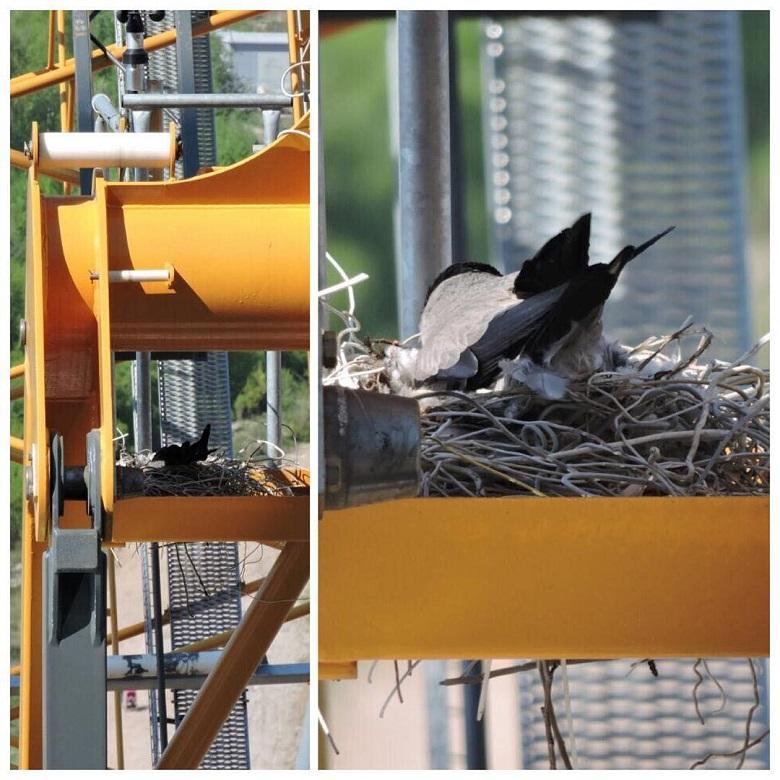
Video about how the Petersburg TV tower was built - until May 10, the tallest building in the northern capital and the Lakhta Center skyscraper, which took the high-altitude baton.
-
The crane operators of the Lakhta Center were visited by the photographer Nikita Grigoriev.

Find out what's up there? Our guides today are the people who drive the highest cranes in the city.
')

If you walk 326 meters along the road, it will take you about 4 minutes. The environment during this time is unlikely to change much. But if you go up the same distance, then there things are different.
There is another air, wind and temperature. There are the paths of "bird migrants" and glide paths of aircraft. There, the lower cloudy tier rushes toward the fog rising from the ground. Mosquitoes do not fly there ... And skyscraper builders are working on this mark.

Above all - crane operators "K-1", "K-2", "K-3" and of course, "K-4" - a lifting machine, mounted in the core of the tower Lakhta Center. Rise to them. But first - we learn that they control the machines.

Great Ka
There are 16 lifting machines at the Lakhta Center construction site. At all - one name, "K", plus a serial number.

Construction site, April 2017
Cranes differ in type - there are classic cranes with a tip and with a swinging boom. The first is used to move goods horizontally, the second - for vertical transportation. It is possible to distinguish machines in the following way: cranes with a swinging arm can understand it almost vertically upwards, and the counterweight is located compactly on the platform next to the tower. In the "classic" arrow has a "tail" - a console with a counterweight.

Photo - Ilya @yosivim Nekrasov
Construction legend has it that a fly-up arrow was invented in the UK. Allegedly, according to local laws, the landlord owned not only the land, but also the airspace above it. In the process of construction not to invade "in the air" of a neighbor, I had to invent something. That crane appeared, capable of raising the boom almost vertically, with fundamentally smaller turning radius.
In connection with this story, it is thought that it is not only a matter of violating the neighboring airspace, but also of all dense urban development. Today, the construction of buildings sometimes goes on so compact spots that it’s scary not for air, but for neighboring objects. Here, for example, how MoMa was built - a museum of modern art in New York. Well, where would the traditional tap turn?
Above the multifunctional building work cranes, both traditional and with a swinging arm - three of each kind. At the height of the growth of the highest machines of this working group will reach 95 meters. It inspires, given that these are separate cranes that do not have a fastener to the building.

MFZ cranes
Above the construction of the flagship of the complex, the 462-meter tower, four supermachines are working. The disposition is as follows. Around the skyscraper are located "K-1", "K-2" and "K-3", model 710 HC-L 32/64 Litronic.

Layout of cranes for work with the building of a skyscraper. For comparison - next to the scale is a piece of the MFZ building and a crane for it.

These are the highest cranes in the city. And in general - the biggest cranes with swinging arm, produced by "Liebherr". The departure of their arrows is 45, 50 and 60 meters. The maximum carrying capacity is 64 tons, the speed of movement of the load is 176 meters per minute. Faster than a regular elevator.

Cranes grow with the building — about a quarter of a time additional sections are added to the mast. At the peak of the growth of cars will step over the 400-meter mark. One of the "libkers" will grow to 440 meters already in the summer - it is with its help that the tower spire will be installed.

"K-2" took a height of 320 meters
Of course, these cranes have attachments to the building.

Are taps higher? The largest crane of those that built the Burj Khalifa megatoll has grown to 750 meters.
Cranes burj khalifa
Today, when it comes to buildings of 1000+ meters, we will have to make cranes higher. Or not? Let's look at “K 4” from our construction site.

This machine closes the skyscraper quartet load. Although the K 4 is also the Liebherr, model 357 HC-L 12/24, it is, in a way, a legacy of Soviet engineers. In the 50s of the last century, when Stalin's skyscrapers were erected, UBK - universal tower cranes were first tested. Development of engineers P. P. Velikhov, L. N. Shchipakina, I. B. Gitman and A. D. Sokolov. Everyone was awarded the Stalin Prize for this work.
The essence of innovation is as follows. The UBC, and now its “heirs,” do not have the traditional ground support with a mast build-up during the construction process. It relies on the construction of the building itself. The building is growing - the crane moves to a new level. Therefore, it is also called self-climbing or creeping.
"K 4" is mounted in the elevator lobby of the core of Lakhta Center. To change positions, the crane is lifted hydraulically and a new section is built in.
It turns out that the height of the work of such a crane is limited only by the growth of the building. You understand who most appreciated this innovation. Take a photo strongly of any skyscraper during construction, and in the center of the core you will see a self-lifting worker. Sometimes - not even one. Unfortunately, he still cannot completely replace the traditional tap. But this is a quick and easy forward, always at the peak of the process.

K-4 is now at the zenith of construction. His boom reaches up to 417 meters, the cabin has a height of 380. Views from there are the same ones that will be on the observation platform of a skyscraper, only earlier and without a queue. Look in?
stairway to Heaven
The path to the cabin is one - the stairs. There are no special elevators in the crane for this purpose.

Can fellow crane operators "toss" each other at work and back? No, because of the first and sufficient - is unacceptable for safety. Violation is possible only in extreme cases. Last winter, when the support of the WHSD under construction caught fire, crane operator Tamara Pastukhova lowered 3 workers from a 100-meter height in an improvised “cradle”. Such situations transportation of people by crane and limited.
However, it is still possible to cut the way up a bit. In Lakhta Center, crane operators drive up to the 55th floor in an elevator located in the tower itself. From there - on the transition ladder get over to the crane mast. But further - without options, on foot.
Transition bridge:


If it were not for this maneuver, then to climb into the cabin "K-1", "K-2" or "K-3", it would be necessary to overcome more than 700 steps. Those who work at K-4 are more fortunate - the height of the cabin is “only” 50 meters, but you cannot block the road either.
In any case - the crane operator once again does not run down. Even they have lunch at home. Tea can be drunk on the spot. But a hot lunch is delivered from the ground.

Lunch with a view is better than in a panoramic restaurant.
Work and weather
After the march to the workplace - sit-down 8-hour shift in a small cabin. Everything you need here is at hand. Two levers are responsible for turning the tower and lifting the load.

The on-board computer displays the current parameters - boom reach, load capacity, rope length, turning radius and wind speed.

On the monitor - a unique minute - calm. Perhaps this will happen again for a brief moment once or twice a year.
“The most difficult thing in our work is the weather,” says Sordar, manager of K 2. “The weather like this is not hard.” I hope one or two days this normal weather will stay. Usually - constant wind.
Wind has to take into account all who work in the air. But if it is sometimes for aircraft only to help, then for wind cranes any wind is a hindrance. During a storm, work has to be stopped altogether. In this case, the flywheel boom cranes rise up for greater stability of the machines.

Storm. Fly arrows - in the wind, turning mechanism - on the "neutral" - for minimal resistance to impulses
Weather - the only thing that brings construction. "Distinguished" the last two years. In 2015, there were 159 storm warnings, in 2016 - already 258. 2017 seems to be going to continue the progression. But the wind is not everything. Most of the time, crane operators carry their loads “by instrument”.
- When the fog starts, we will have a hard work. We will only be on the radio working teams listen. But nothing will be visible below. In this weather, like today, work normally. But what is below is also not clearly visible. Through the camera look. And slingers listen.

Camera "bottom view"
Poor visibility - not just because of the height, rain or fog. The skyscraper and its cranes have grown to the clouds.

Photos of Nikolai Ivanov
Insidious and low cloud type
Clouds are not always about kilometers above the ground. The base of their lower tier can begin even from a hundred meters.
There are two low cloud types at once - clouds are layered and simply layered. The former are also called “bad weather clouds” and everything is clear with them. But the second type is characterized by increased deceit towards builders. On his conscience - a good dozen of false calls of fire and rescue services at the construction site.

And such "state of emergency" for the year was not one
It's all about shape and color. Such low stratus clouds have the form of "ragged" and "torn", "resemble the fog." But it is only when they abstractly float across the sky, attracting the attention of only weather forecasters. If such a cloud is unaccompanied during the flight, it is not far from the tower, then many immediately realize: “fire!”

The press service tirelessly thanks the citizens for their vigilance and non-indifference, but asks first to clarify the causes of "smoke" in the Lakhta Center. Even in the event of a real state of emergency, there is a 24-hour fire brigade at a construction site and it will take all the necessary measures.

If we ignore the unusual properties of clouds to cause panic, we can recall that this weather phenomenon is simply beautiful. There is even a “Cloudy Floor” in the London Splinter to watch him.
But the clouds from the cranes of a skyscraper.



The photo with the clouds was made by the leading engineer of the building control department of Lakhta Center Alexey Sivoho
But the unforgettable - the first meeting with low clouds and rising mist.

August 2016. Photographer - Aleksey Mayorov
The sun
The average number of sunny days in St. Petersburg is about 70. But the crane operators of the skyscraper have more of them - due to reaching the lower edge of the clouds. This is sometimes enough to see the sun.

The cabin has a visor with dimming. But it is clearly not enough - crane operators are saved by thick curtains. In case of heat there are vents. In the breaks, you can go out to warm up on a small platform and see the most beautiful sunrises or sunsets in St. Petersburg.


Who flies here?
326 meters - atypical height for aircraft flight. Nevertheless, in the lower corridor you can often notice small helicopters - for short distances, climbing may be unnecessary.

Small aircraft does not lag behind either - perhaps to show beautiful views of the city to its passengers. Soon such panoramas will be available from the Lakhta Center observation platform.

Sea facade of St. Petersburg - view from the crane
For large aircraft 326 meters - "shallow", below the height of the circle. This is just for takeoff or landing. "Rosaviatsia" by the way, the skyscraper approved - the glide paths are held in another part of the city. A tower can serve as a symbolic beacon not only for ships, but also for those who hurry to earth from the depths of the aerial ocean.
Birds

Illustration from here
Surprisingly, with birds the situation is more severe than with aircraft. It is assumed that the birds may suffer due to a collision with the building. The fact that birds successfully fly around any other obstacles doesn’t count. There is a version that panoramic glazing can disorient them. Therefore, ornithologists began their observations of the behavior of "bird migrants", as they call the wards, from 2011. So far, everything speaks in favor of the bird mind. From the latest expert opinion:
“Above the construction area there are insignificant movements of synanthropic species - gray crows, gulls, successfully avoiding collisions with tall structures and cranes. Part of the silver gulls moved from the Novoselkovskoy dump to the Neva Bay and back at altitudes from 100 to 200 meters. The flight directly above the construction site was rarely observed, no collisions with the structures were registered. Glazing of the floors of a high-rise building did not cause collisions of birds with structures. ”
Crane also do not observe any misunderstandings with birds. Even on the contrary =)

Finally
Video about how the Petersburg TV tower was built - until May 10, the tallest building in the northern capital and the Lakhta Center skyscraper, which took the high-altitude baton.
-
The crane operators of the Lakhta Center were visited by the photographer Nikita Grigoriev.
Source: https://habr.com/ru/post/403751/
All Articles
